The SandForce Roundup: Corsair, Kingston, Patriot, OCZ, OWC & MemoRight SSDs Compared
by Anand Lal Shimpi on August 11, 2011 12:01 AM ESTAnandTech Storage Bench 2011 - Light Workload
Our new light workload actually has more write operations than read operations. The split is as follows: 372,630 reads and 459,709 writes. The relatively close read/write ratio does better mimic a typical light workload (although even lighter workloads would be far more read centric).
The I/O breakdown is similar to the heavy workload at small IOs, however you'll notice that there are far fewer large IO transfers:
| AnandTech Storage Bench 2011 - Light Workload IO Breakdown | ||||
| IO Size | % of Total | |||
| 4KB | 27% | |||
| 16KB | 8% | |||
| 32KB | 6% | |||
| 64KB | 5% | |||
Despite the reduction in large IOs, over 60% of all operations are perfectly sequential. Average queue depth is a lighter 2.2029 IOs.
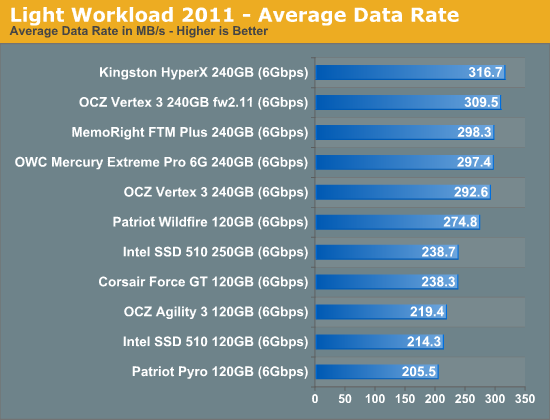
As the only 240GB drive running 3.20 the Kingston HyperX is the fastest drive in our test here (only the Vertex 3 and possibly the Corsair Force GT even have 3.20 available for update). The advantage is still pretty small though, at 6% above its closest competitor in an IO bound test you'll never see that advantage in the real world.
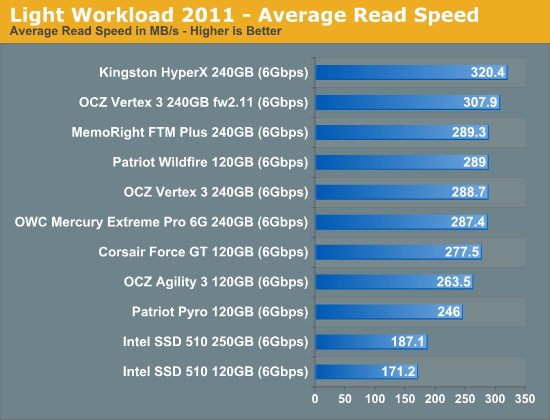
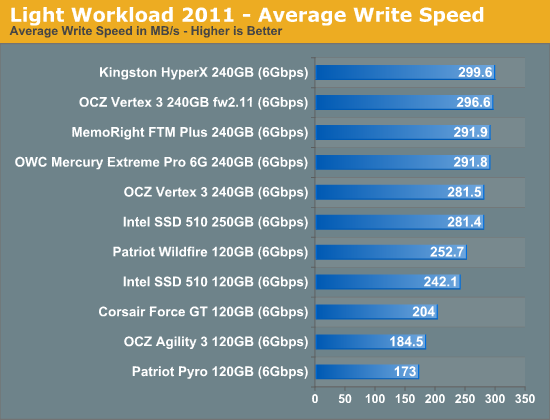
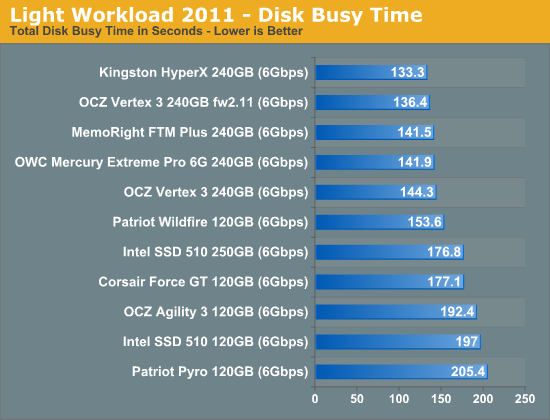

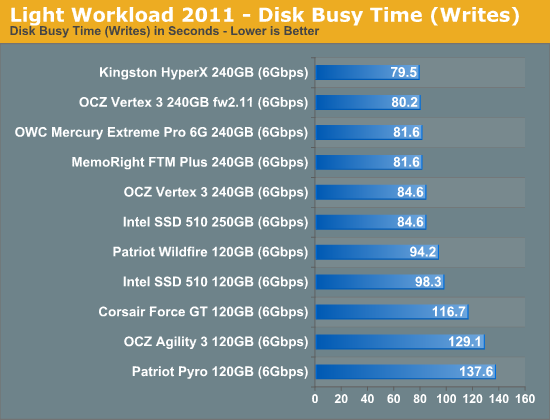










90 Comments
View All Comments
V3ctorPT - Thursday, August 11, 2011 - link
Exactly what I think, I have an X25-M 160Gb and that thing is still working flawlessly with the advertised speeds, every week he gets the Intel Optimizer and it's good...Even my Gskill Falcon 1 64Gb is doing great, no BSOD's, no unexpected problems, the only "bad" thing that I saw was in SSD Life Free, when it say's my SSD is at 80% of NAND wear n' tear, my Intel is at 100%.
CrystalDisk Info confirms those conditions (that SSD Life reports), Anand, do you think these "tools" are trust worthy? Or they're some sort of scam?
SjarbaDarba - Sunday, August 14, 2011 - link
Where I work - we have had 265 Vertex II drives come back since June 2010.That's one every day or two since for our 1 store, hardly reliable tech.
Ikefu - Thursday, August 11, 2011 - link
"a 64Gb 25nm NAND die will set you back somewhere from $10 - $20. If we assume the best case scenario that's $160 for the NAND alone"I think you meant to say an 8Gb Nand die will set you back $10-$20. Not 64Gb
Yay math typos. Those are always hard to catch.
bobbozzo - Thursday, August 11, 2011 - link
No, 64Gb = 8GBNote the capitalization/case.
Ryan Smith - Thursday, August 11, 2011 - link
We're using gigaBITs (little b), not gigaBYTEs (big B).64Gb x 16 modules / 8 bits-to-bites = 128GBytes.
Ikefu - Thursday, August 11, 2011 - link
Ah Capitalization for the loss, I see my error now. Thank you =)Later in the article they refer to 8GB so the switch from Gigabits to Gigabytes through me.
philosofool - Thursday, August 11, 2011 - link
I made the same mistake at first.Can I request that, in the future, we write either in terms of bytes or bits for the same type of part? There's no need to switch from bits to bytes when talking about storage capacity and you just confuse a reader or two when you do.
nbrenner - Thursday, August 11, 2011 - link
I understand the GB vs Gb argument, but even if it takes 8 modules to make up 64Gb it was stated that a 64Gb die would set you back $10-$20, so saying a 128Gb drive would cost $160 didn't make any sense until 3 paragraphs later when it said the largest die you could get is 8GB.I think most of us read that if 64Gb is $10-$20, then why in the world would it cost $160 to get to 128Gb?
Death666Angel - Friday, August 12, 2011 - link
Unless he edited it, it clearly states "128GB". I think the b=bit and B=byte is quite clear, though I would not complain if they stick with one thing and not change it in between. :-)Mathieu Bourgie - Thursday, August 11, 2011 - link
Once again, a fantastic article from you Anand on SSDs.I couldn't agree more on the state of consumer SSDs and their reliability (or lack of...).
The problem as you mentioned is the small margins that manufacturers are getting (if they are actually manufacturing it...), which results in less QA than required and products that launch with too many bugs. The issue is, this won't go away, because many customers do want the price per GB to go down before they'll buy. Probably waiting for that psychological $1 per GB, that same 1$ per GB that HDDs reached many years ago.
With prices per GiB (actual capacity in Windows) dropping below $1.50, reliability is one of the last barrier for SSDs to actually become mainstream. Most power users now have one or are considering one, but SSDs are still very rare in most desktops/laptops sold by HP, Dell and the like. Sometimes they will be offered as an option (with additional cost), but rarely as a standard drive (only a handful or two of exceptions come to mind for laptops).
I can only hope that the reliability situation improves, because I do wish to see a major computing breakthrough, that is for SSDs to replace HDDs entirely one day. As you said years ago in an early SSD article, once you had a SSD, you can't go without one.
My desktop used to have two Samsung F3 1TB in RAID 0. Switching to it from my laptop (which had an Intel 120GB X25-M G2) was almost painful. Being accustomed to the speed of the SSD, the HDDs felt awfully slow. And I'm talking about two top of the line (besides raptors) HDDs in RAID 0 here, not a five year old IDE HDD here.
It's always a pleasure to read your articles Anand, keep up the outstanding work!